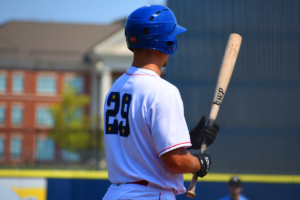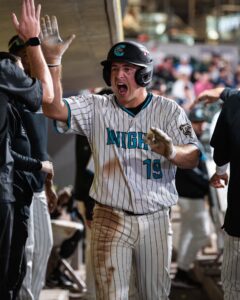In-person reports – Six Kannapolis pitchers
***This article is really a two-writer effort. Rob Young wrote up Bernardo Flores, Jimmy Lambert and Mike Morrison, while I wrote on Chris Comito, Danny Dopico and Kevin Escorcia.
Having covered four games in Kannapolis, we saw every pitcher on the Intimidators roster throw in-game at least once, except Yosmer Solorzano. We already wrote in-depth about Alec Hansen here. Here, we will be covering the other three starters we saw, as well as three relievers to keep an eye on.
Jimmy Lambert
Jimmy Lambert was taken in the 5th round of the seemingly quite fruitful 2016 draft class. He had interest from teams in the 3rd and 4th rounds, so Lambert is another story of Sox good draft fortunes. After throwing 97.2 innings in college with Fresno State, the Sox put him on a strict innings limit in his pro debut, so he never threw more than three innings at a time with plenty of rest between. He made just four appearances with the rookie-level Arizona White Sox before heading to Kannapolis, where he ran into a lot of contact and ended up with a 5.76 ERA.
2017 has been a completely different story for Lambert. The slender (he is listed generously at 6’2”, 170) right-hander has held up against the South Atlantic League with a 2.72 ERA and only six walks over 43 innings. I caught Lambert on a day where he was victimized by some suspect defense. He allowed six runs over six innings, but only three of those were earned and at least one run shouldn’t have been, as Joel Booker lost a routine fly ball in the lights and it fell for a “hit.”
Lambert starts his delivery with an up-down-up glove movement that varies in speed as he starts his leg kick and drive towards the plate. It’s not quite at Ryan Dempster glove-flip territory, but its rather pronounced and takes a bit to get used to. Once he gets past the pre-release noise, he has a relatively easy, repeatable delivery. Despite not having ideal starter size, he has had no trouble going deep into games this year and maintains his velocity throughout. He leans heavily on four-seam and two-seam fastballs that he throws between 88-92. Behind his fastballs Lambert displayed three off-speed pitches that he commanded and flashed at certain times. He has a tight slider he throws 81-85, a sharp curveball he used for at least one strikeout between 71-75, and finally a developing change-up that has a solid 10 MPH difference off his fastball. Lambert told me that he is throwing a lot more change-ups than he ever has in the past, and he showed some promising feel for it.
The biggest takeaway from seeing Lambert live is that he is a competitor. He has a bulldog type of mound presence and goes after hitters aggressively, sometimes living too much in the zone because of it. Personally, I’d rather see this level of command with developing stuff, than the inverse control problems that many young pitchers have. Lambert’s likelihood of sticking as a starter and rising through the system largely depends on the development of his secondary pitches, especially his change-up. If he can keep hitters honest with a deceptive change-up to compliment his fastball, he will advance quickly.
Bernardo Flores
Flores was selected out of the University of Southern California two rounds after Lambert and was scouted by Kenny Williams Jr., the Southern California area scout. The selection was a bit of a surprise, as Flores put up a 6.70 ERA with the Trojans working predominantly out of their bullpen. However, the Sox saw a starter and he immediately rewarded the faith with a strong pro debut, reportedly topping out at 97 MPH on his fastball and posting a 3.46 ERA with 52/12 K/BB rate over 65 innings almost entirely in rookie-level Great Falls. The White Sox moved Flores up to Kannapolis this season and he has performed well statistically, striking out nearly a batter an inning and posting a 3.92 ERA over 43.2 frames. On the day I saw Bernardo, he didn’t have his best stuff, striking out one batter, issuing two walks, and allowing four “earned” runs. I put “earned” in quotes because similar to Lambert’s start, Flores defense lost several routine pop-ups in the sky that fell for hits.
Flores starts his delivery with his hands high and uses a big leg kick as he sweeps towards the plate, dropping the ball behind him before throwing at a traditional 3/4 arm slot. With his leg kick and torso rotation, his delivery has a little deception to it, playing up his stuff a tick. He is fairly coordinated throughout his delivery, though on certain pitches his arm drags behind the rest of his body. He maximizes his lower half well, driving on his plant leg and finishing balanced towards the plate.
Charting Flores’ pitches was a real adventure. I had heard about the inconsistent velocity coming into this start, but I was scrambling on several pitches trying to verify the readings. His fastball topped out at 91 in the 3rd inning, coincidentally immediately after he surrendered a home run. But aside from that, he was 86-90 in the first three innings, then 83-87 in the 4th, his final inning. His curveball was mid-70’s in the early innings, but dropped in the 3rd and 4th, hitting 69 MPH a couple times, once on the aforementioned home run. At the higher velocities, his curveball had some bite to it, and he threw it for strikes and buried it effectively. It’s a pitch that is still clearly a work in progress, as he rolled a few through his outing. His best off-speed pitch is his change-up, which he threw between 74-82, featuring some cutting action. In my interview with him, Flores said “things are tough” right now with his change-up, and it wasn’t as effective as I’ve heard it has been in previous starts. When he threw it well, he mimicked his arm action off his fastball and combined with some deception in his delivery, its easy to project it as a plus pitch in the future.
As a total package, Flores is an intriguing prospect with a solid skill set. He is a difficult projection considering the velocity fluctuations and the developing secondary stuff, and the range of possible outcomes is wide. Best case scenario: his velo firms up, change-up becomes a consistent weapon, and his curveball development continues, and I could squint and see mid-rotation starter upside.
Chris Comito
Comito is the rare (for the White Sox) pitcher drafted out of high school, and in his case he was taken in the 15th round in 2015 but received a bonus more in line with the 8th. Last year as a 19-year old, he opened the season in full season ball with Kannapolis but was hit hard and sent down to Great Falls where he fared much better. Now this year he’s being tested again in the South Atlantic League.
We caught his second start at this level this year, and it didn’t go well – in 3.1 innings, he allowed 6 runs on 8 hits and 4 walks without striking out a batter. As this was his roughest start statistically since a year ago at this time, it’s likely we did not see him at his best, but we can only report on what we saw. Here’s a notebook dump-style report on what was on display in his start:
- Build: solid base, slender upper body, broad shoulders could add muscle. Good frame to work from at 6’6″.
- Arm slot is typical 3/4, medium effort, fairly efficient to plate. But he’s very upright and arm-heavy.
- Fastball ran 86-89, mostly in lower half of that band. Does have some run and sink.
- Slider in the high 70’s, and in this game at least, wasn’t moving much.
- Change-up was 79-83 with some arm-side fade, and was probably his best looking pitch, but the velocity gap versus the fastball wasn’t wide enough.
- Shows athleticism when defending the position despite tall frame.
There wasn’t a lot in the way of highlights from this start, but here are a couple videos to get an idea of how he looked – one from straight on the other open-sided:
Comito was getting hit hard on all his pitches, and he wasn’t locating well either (especially with the offspeed pitches, with at least a half dozen bouncing before reaching the catcher). We will do a follow-up later with Chris and/or his pitching coach, Matt Zaleski, to see what may have been going on and if these pitches were representative of his normal stuff.
Mike Morrison
Morrison was a 27th round draft pick who raised his profile considerably post-draft when he and fellow Coastal Carolina Chanticleer Zach Remillard won the NCAA Tournament. The White Sox sent Morrison immediately to Kannapolis, where he pitched well (3.63 ERA), but if we are being picky, struggled with his control a bit (8 BB’s) and gave up two home runs over 17.1 innings. This season the White Sox had Morrison back at Kanny and he has been unbelievably dominant, so much so that at the time of this publication, he still hasn’t been scored upon over 17.1 innings. Not only has his ERA been perfect, he has only allowed 4 hits, struck out 26, and issued only 3 walks, a marked improvement from last season. Whats working so well? Let’s go to the video:
The biggest thing that jumps out at you when you see Morrison’s delivery is the head-whack, or as his pitching coach Matt Zaleski lovingly termed it, “head violence.” Morrison’s head jerks off to the side at the time of release into his follow-through, causing him to fall slightly off to the side of the mound. According to Zaleski, his delivery is much cleaner from last year, which would explain the improved walk rate at the same level.
Morrison’s velo chart isn’t overwhelming, despite what you might expect from his stats this year. His fastball sat between 90-91 MPH and he showed the ability to elevate it and also throw it down in the zone for strikes. Morrison and Zaleski both mentioned he is working on throwing his fastball with a strong downward angle and I saw that progression in his appearance. Thanks to his violent delivery, I doubt his command will ever be pinpoint, but he certainly has made strides in that area. Morrison has three breaking balls (slider, curveball, and change-up), though he only threw the slider and curve when I saw him. I have heard the change-up is a work in progress and judging from his two other off-speed pitches, it may be superfluous aside from a “show-me” pitch. The slider is tight, late breaking, and hard at 84-85 MPH and he grabbed strikes with it in odd counts when hitters were expecting the fastball. Mike hinted at this in our interview with him:
I’ll show fastball, then go breaking ball, or sometimes open with my slider. My thought is if they see one, you expect one, but get another, you get a lot of swings and misses at this level so I like to mix it up… I’ll dump in a breaking ball early because they’re not going to be sitting first pitch breaking ball in that situation.
The curveball comes in at 78-81 MPH and he showed good spin and tilt, often burying it in the dirt and inducing embarrassing offerings by hapless Low-A hitters. Armed with these two potentially plus breaking balls and improved control over his fastball, it is now easy to see why he is blowing away South Atlantic League hitters at a preposterous rate. Morrison is overdue for a promotion and it even wouldn’t surprise me if he ends the year in Birmingham with his advanced repertoire.
Danny Dopico
This 2015 11th round pick first hit our radar that fall, when we got some positive reports from Fall Instructs. He opened 2016 skipping Kannapolis to go to Winston-Salem, adding further smoke around his profile, but he struggled with wildness (33 walks in 30 innings) and was sent back to rookie affiliate Great Falls and later Kannapolis.
Our two looks at Danny on this trip reinforced the good and bad. We’re covering him here because the potential is there for a major league reliever. The 23-year old offers a fastball that runs 92-94 with substantial fade, a slider around 79-82 with big movement (mostly downward, slight turn), and a splitter in the low 80’s that drops off the table nicely. The problem is, it seems he really doesn’t know where it’s going, so command is very much lacking at this point. Here’s a video of an at-bat from our first look, where you get to see all three offerings:
His location improved in the second look, and when he’s around the plate he’s very effective. His delivery isn’t as consistent as you’d like to see, but it’s not all over the place either. It’s a semi-high effort process, though he’s got a decent frame for it. It’s entirely about command here, as the stuff is worthy of much higher level competition. The Jekyll and Hyde nature of the two outings are reinforced by an improved but still somewhat high walk rate this year. If he can continue improving his location, he’s got a shot.
Kevin Escorcia
Here is the only reliever we saw in Kannapolis who was not at all on our radar, but got our attention anyway. The Columbian left-hander has been slow-walking through the system, with two years in the DSL followed by one year at each rookie affiliate stateside, landing him in Kannapolis for his age 22 campaign here in 2017.
Escorcia is a slender 6’1″, with a delivery that starts with a slow rock back and an explosive forward delivery from a low 3/4 slot. His fastball didn’t show much velocity (88 to 92, but mostly around 89-90), but he was locating it to both sides pretty well and it had some sink. He also had a slider running 79-81 with a nice, late two-plane break. But the main event here is a curveball in the mid-70’s that had seriously big bend. Multiple hitters were seen leaning back to get out of the way of a pitch that was called a strike or just missed. Check the tape here:
I can see a major league LOOGY profile developing here. He locates well for this level, his pitches all move, the curveball has plus potential and he looks like he can still add muscle to his frame. His delivery angle adds to his strength against left-handed batters, with them hitting just .167 against him this year. He’s not a name we’ve seen discussed elsewhere, but is definitely an arm to watch.
Want to know right away when we publish a new article? Type your email address in the box on the right-side bar (or at the bottom, if on a mobile device) and click the “create subscription” button. Our list is completely spam free, and you can opt out at any time.






